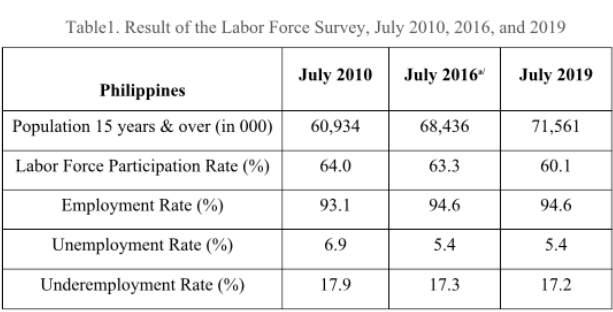Employment rate in July 2019 at 94.6 percent
Two weeks ago, the Philippine Statistics Authority (PSA) reported that the country’s employment rate in July 2019 was estimated at 94.6 percent or an unemployment rate of 5.4 percent.
Three years earlier in 2016, when the present administration started, the employment and unemployment rates were placed at the same rates in July this year. In 2010 when the previous administration started, the employment and unemployment rates were 93.1 percent and 6.9 percent, respectively.
In July this year, Regions with lowest employment rates were Region IV-A (CALABARZON) (92.8 percent), National Capital Region (NCR) (93.9 percent), Region VII (Central Visayas) (94.0 percent), and Region VI (Western Visayas) (94.1 percent).
In the Philippines, anyone who reached the age of 15 is considered part of the working age group. The labor force consists of the fraction of the working age group who are employed and the unemployed 15 years old and over. Also known as the labor force participation rate (LFPR), this fraction is the ratio of the labor force to the working age group. The LFPR tends to be high when jobs are plentiful and low when jobs are scarce.
In July this year, the LFPR was estimated at 62.1 percent, lower than the 63.3 percent in July 2016 and the 64.0 percent in July 2010.
Workers are grouped into three broad sectors, namely, agriculture, industry and services sector. Workers in the services sector comprised 57.8 percent of the total employed in July 2019, the largest proportion of the employed population.
Workers in the agriculture sector comprised the second largest group making up 23.5 percent of the total employed in July 2019, while workers in the industry sector made up the smallest group registering 18.7 percent of the total employed.
Employed persons are categorized into (1) wage and salary workers, (2) self-employed workers without any paid employee, (3) employers in own family-operated farm or business, and (4) unpaid family workers. Wage and salary workers are those who work for private households, private establishments, government, or government-controlled corporations, and those who work with pay in own family-operated farm or business.
In July 2019, the wage and salary workers made up 63.4 percent of the total employed, with those working in private establishments continuing to account for the largest share. They made up 49.7 percent of the total employed in July 2019. Self-employed workers made up 27.3 percent of the total employed in July 2019 while unpaid family workers accounted for 6.4 percent of the total employed.
Employed persons who expressed the desire to have additional hours of work in their present job, to have additional job, or to have a new job with longer working hours are considered underemployed. In July 2019, the underemployment rate, which is the percentage of the underemployed to the total employed, was estimated at 13.9 percent.
Underemployed persons who worked for less than 40 hours in a week are called visibly underemployed persons. They accounted for 62.3 percent of the total underemployed in July 2019.aThe underemployed persons who worked for 40 hours or more in a week in July 2019 made up 37.7 percent. By sector, 46.4 percent of the underemployed worked in the services sector, while 34.6 percent were in the agriculture sector. Those in the industry sector accounted for 19.0 percent.
Among the unemployed persons in July 2019, 60.6 percent were males. Of the total unemployed, the age group 15 to 24 years comprised 45.5 percent, while the age group 25 to 34, 33.2 percent. By educational attainment, 30.2 percent of the unemployed were college graduates, 8.0 percent were college undergraduates, and 25.2 percent have completed junior high school. Graduates of junior high school include those high school graduates in the old curriculum.
Disclaimer: The comments uploaded on this site do not necessarily represent or reflect the views of management and owner of Cebudailynews. We reserve the right to exclude comments that we deem to be inconsistent with our editorial standards.


